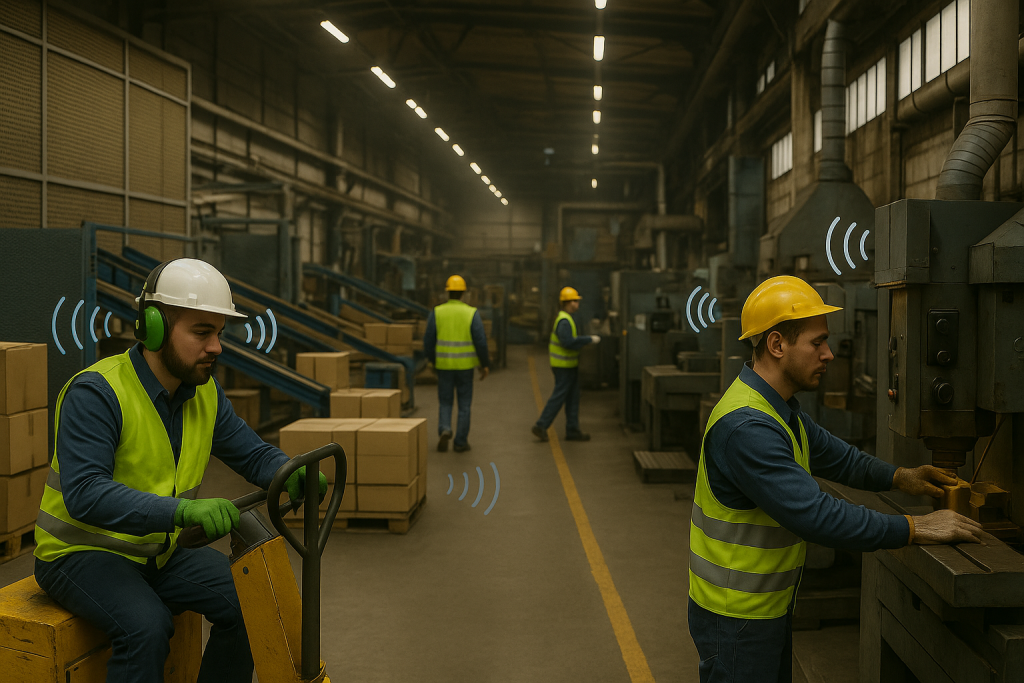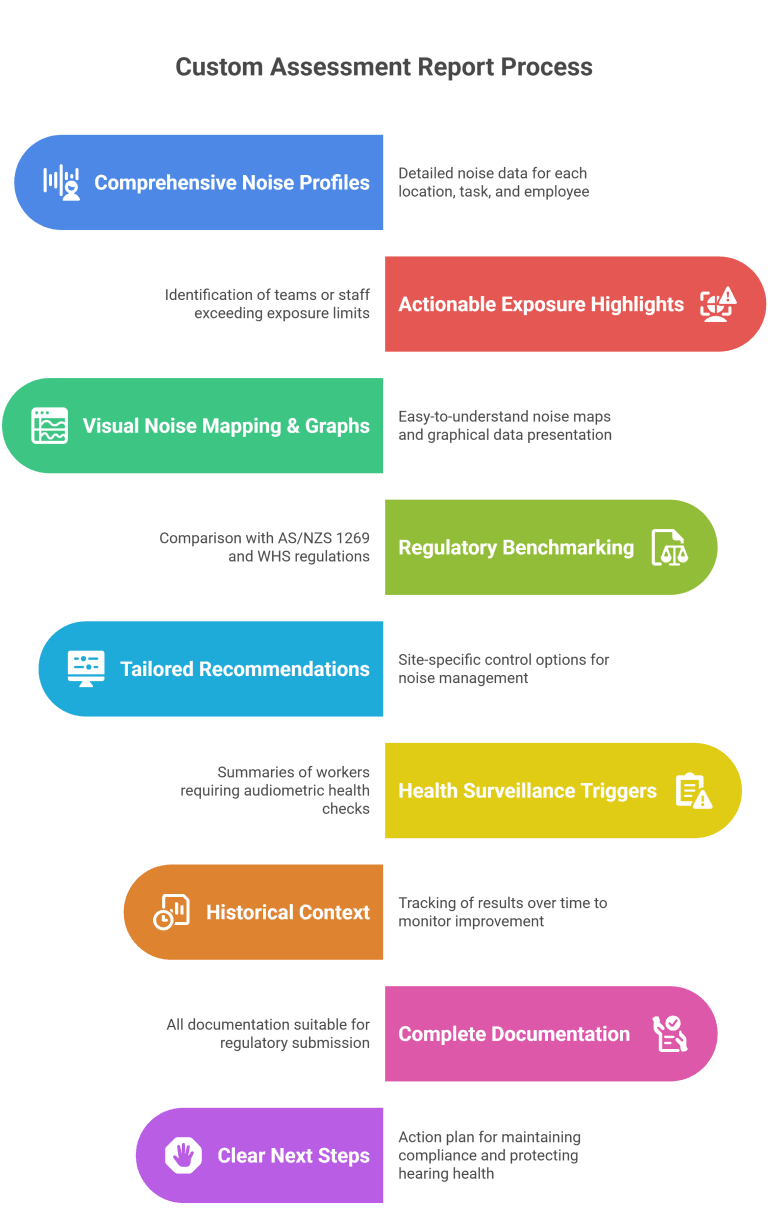TEST
Noise Assessment Services

Understanding Occupational Noise Risks
Excessive workplace noise is a leading cause of hearing loss in Australian workplaces. Unmanaged noise impacts not only worker health and safety but also communication, productivity and regulatory compliance. An effective workplace noise assessment, also known as occupational noise assessment, is essential to protect your people and fulfil your legal obligations.
Why Is a Noise Assessment Required?
- Under Australian Work Health and Safety (WHS) and/or Occupational Health and Safety (OH&S) Regulations, a Person Conducting a Business or Undertaking (PCBU) must identify, assess and control risks from hazardous noise.
- Workplace noise must not exceed 85 dB(A) averaged over an 8-hour shift, or 140 dB(C) peak.
- Workplace noise assessment is required when hazardous exposures are suspected, following changes in equipment or processes, or to maintain compliance.
- If noise risks persist, a hierarchy of controls is mandated: engineering controls (such as enclosures and maintenance), administrative controls (e.g. scheduled breaks), and personal hearing protection as a last resort.
- Health surveillance, including audiometric testing, is required for workers who are required to wear hearing protection devices to control noise exposure.
Our Occupational Noise Assessment Services
Occupational Hygiene & OHS Solutions (OHOS) Pty Ltd supports clients across Australia with a comprehensive suite of services, including:
1. Preliminary Site Assessment
- Identification of significant noise sources and at-risk areas.
- Walk-through survey of site and activities.
2. Comprehensive Noise Monitoring & Exposure Analysis
- Using calibrated sound level meters and personal noise dosimeters as per AS/NZS 1269.1
Occupational noise management, Part 1: Measurement and assessment of noise immission and exposure
. - Measurement of occupational (personal) exposures.
- Noise mapping and identification of Similar Exposure Groups (SEGs).
3. Data Interpretation & Reporting
- Full analysis benchmarked to regulatory and industry standards.
- Clear documentation of findings for all relevant workplace locations, tasks and employees.
4. Tailored Noise Management & Control Advice
- Prioritised recommendations for engineering, administrative and PPE controls.
- Development of workplace noise management plans including ongoing monitoring.
5. Worker Health Surveillance Coordination
- Assistance with the setup of baseline and ongoing audiometric testing for staff exposed to hazardous noise.
The OHOS Noise Insight Advantage: Your Custom Assessment Report
When you choose Occupational Hygiene & OHS Solutions (OHOS) Pty Ltd, you get more than just measurement results. Our OHOS Noise Insight Report delivers:
Our reports transform technical noise data into practical risk management and compliance solutions—giving you clarity, insight, and peace of mind.

Legal & Technical Framework
1. Exposure Standard: 85 dB(A) LAeq,8h and 140 dB(C) peak [Safe Work Australia].
2. Standards:
- AS/NZS 1269 Series – Occupational noise management.
- Safe Work Australia: Code of Practice: Managing Noise and Preventing Hearing Loss at Work.
3. Additional state-specific and EPA guidelines may apply (e.g., WorkSafe Victoria, EPA VIC).
Why Choose Occupational Hygiene & OHS Solutions (OHOS) Pty Ltd?
- More than 25 years’ experience in occupational noise assessment, management, and compliance.
- Certified, independent occupational hygienists servicing all regions of Australia.
- Actionable, clear reporting, matched to regulatory requirements.
- Flexible, client-focused service—onsite, on-shift, with minimal disruption and maximum value.
- National reach, proven expertise and integrity.
Comparison Table: Noise Control Strategies:
| Control Layer | Example Measures | Effectiveness | Application Examples |
|---|---|---|---|
| Engineering Controls | Acoustic enclosures, quiet plant | High | Factory upgrades, new equipment |
| Administrative Controls | Staff rotation, scheduled ‘quiet time’ | Moderate | Production, processing lines |
| Personal Hearing Protection | Earplugs, earmuffs | Moderate/Last resort | Maintenance, construction site |
Frequently Asked Questions (FAQs)
- What does a workplace noise assessment involve?
Detailed measurement of noise exposure at your site, followed by clear interpretation and practical, tailored recommendations. - How frequently should noise be reassessed?
Every five years, or sooner if significant changes occur in processes, equipment, or staff feedback. - What are the legal workplace noise limits?
85 dB(A) LAeq,8h or 140 dB(C) peak, as set by Safe Work Australia and state authorities. - Is audiometric testing required for high-noise workplaces?
Yes—Two yearly testing is required at or above action levels and hearing protectors are required to minimise noise exposure. - Do you conduct workplace noise assessments in Australia?
Absolutely. We deliver reliable, standards-aligned noise assessments and management support throughout Australia.
Contact Occupational Hygiene & OHS Solutions (OHOS) Pty Ltd
For rigorous workplace noise assessment, occupational noise management expertise, or to book your next workplace noise assessment, contact Occupational Hygiene & OHS Solutions (OHOS) Pty Ltd today.

